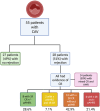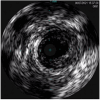Coronary Artery Vasculopathy in a Cohort of Heart Transplant Recipients: A Single Center Experience
- PMID: 40421760
- PMCID: PMC12336783
- DOI: 10.1002/ccd.31633
Coronary Artery Vasculopathy in a Cohort of Heart Transplant Recipients: A Single Center Experience
Abstract
Background: Coronary allograft vasculopathy (CAV) is a significant cause of late mortality in heart transplant recipients. This study assesses the development of CAV, associated rejection rates, and the potential impact of percutaneous coronary intervention (PCI) on survival in a cohort of heart transplant patients.
Methods: We conducted a retrospective analysis of 321 patients who underwent orthotropic heart transplantation (OHT) at Virginia Commonwealth University between October 2008 and September 2021. Data on CAV incidence, PCI, rejection, and mortality were collected. CAV severity was classified by ISHLT criteria, and Kaplan-Meier analysis was used to evaluate survival.
Results: CAV occurred in 55 patients (17%), with a median onset of 2.81 years. Nineteen of these patients required PCI, including three for chronic total occlusion (CTO). Overall mortality was higher in the CAV group compared to the non-CAV group (40% vs. 27%, p = 0.045). Kaplan-Meier analysis revealed no overall survival difference between CAV and non-CAV patients (p = 0.558). Excluding patients with less than 2 years of follow-up, survival significantly favored the non-CAV group (5-year survival: 93% vs. 86%; 10-year survival: 75% vs. 62%, p = 0.023). Patients with CAV who underwent PCI had survival outcomes comparable to those with less severe CAV (p = 0.75). One case involved a 67-year-old female with a right coronary artery CTO, successfully treated with PCI, which maintained vessel patency for an additional 2 years and potentially preserved allograft function.
Conclusion: CAV is a late complication associated with increased mortality, especially in those with moderate to severe rejection. PCI in patients with advanced CAV may help improve survival to levels comparable with less severe CAV. Further research is needed to better understand non-immunologic factors and the role of PCI in long-term outcomes.
Keywords: chronic total occlusion (CTO); coronary allograft vasculopathy (CAV); heart transplant; mortality; percutaneous intervention (PCI); rejection; survival analysis.
© 2025 The Author(s). Catheterization and Cardiovascular Interventions published by Wiley Periodicals LLC.
Conflict of interest statement
The authors declare no conflicts of interest.
Figures






Similar articles
-
Sex and gender as predictors for allograft and patient-relevant outcomes after kidney transplantation.Cochrane Database Syst Rev. 2024 Dec 19;12(12):CD014966. doi: 10.1002/14651858.CD014966.pub2. Cochrane Database Syst Rev. 2024. PMID: 39698949
-
Indobufen versus aspirin after percutaneous coronary intervention in elderly patients with acute coronary syndrome.BMC Cardiovasc Disord. 2025 Jul 7;25(1):495. doi: 10.1186/s12872-025-04843-0. BMC Cardiovasc Disord. 2025. PMID: 40619357 Free PMC article.
-
Exercise-based cardiac rehabilitation for coronary heart disease.Cochrane Database Syst Rev. 2021 Nov 6;11(11):CD001800. doi: 10.1002/14651858.CD001800.pub4. Cochrane Database Syst Rev. 2021. PMID: 34741536 Free PMC article.
-
Outcomes of donation after brain death heart transplantation from older donors: A contemporary analysis of the UNOS database.JHLT Open. 2025 Jun 4;9:100313. doi: 10.1016/j.jhlto.2025.100313. eCollection 2025 Aug. JHLT Open. 2025. PMID: 40635782 Free PMC article.
-
What Are the Complications, Function, and Survival of Tumor-devitalized Autografts Used in Patients With Limb-sparing Surgery for Bone and Soft Tissue Tumors? A Japanese Musculoskeletal Oncology Group Multi-institutional Study.Clin Orthop Relat Res. 2023 Nov 1;481(11):2110-2124. doi: 10.1097/CORR.0000000000002720. Epub 2023 Jun 14. Clin Orthop Relat Res. 2023. PMID: 37314384 Free PMC article.
References
-
- Khush K. K., Cherikh W. S., Chambers D. C., et al., “The International Thoracic Organ Transplant Registry of the International Society for Heart and Lung Transplantation: Thirty‐Sixth Adult Heart Transplantation Report—2019; Focus Theme: Donor and Recipient Size Match,” Journal of Heart and Lung Transplantation 38 (2019): 1056–1066. - PMC - PubMed
-
- Shetty M. and Chowdhury Y. S., Heart Transplantation Allograft Vasculopathy (StatPearls, 2024). - PubMed
-
- Taylor D. O., Edwards L. B., Boucek M. M., et al., “Registry of the International Society for Heart and Lung Transplantation: Twenty‐Fourth Official Adult Heart Transplant Report,” Journal of Heart and Lung Transplantation 26 (2007): 769–781. - PubMed
-
- Cheng R. and Kobashigawa J. A., “Transplant CAD: The Role of PCI in the Transplanted Heart,” ACC.org (2016), https://www.acc.org/latest-in-cardiology/articles/2016/03/18/08/28/trans....
MeSH terms
Grants and funding
LinkOut - more resources
Full Text Sources
Medical
Miscellaneous

